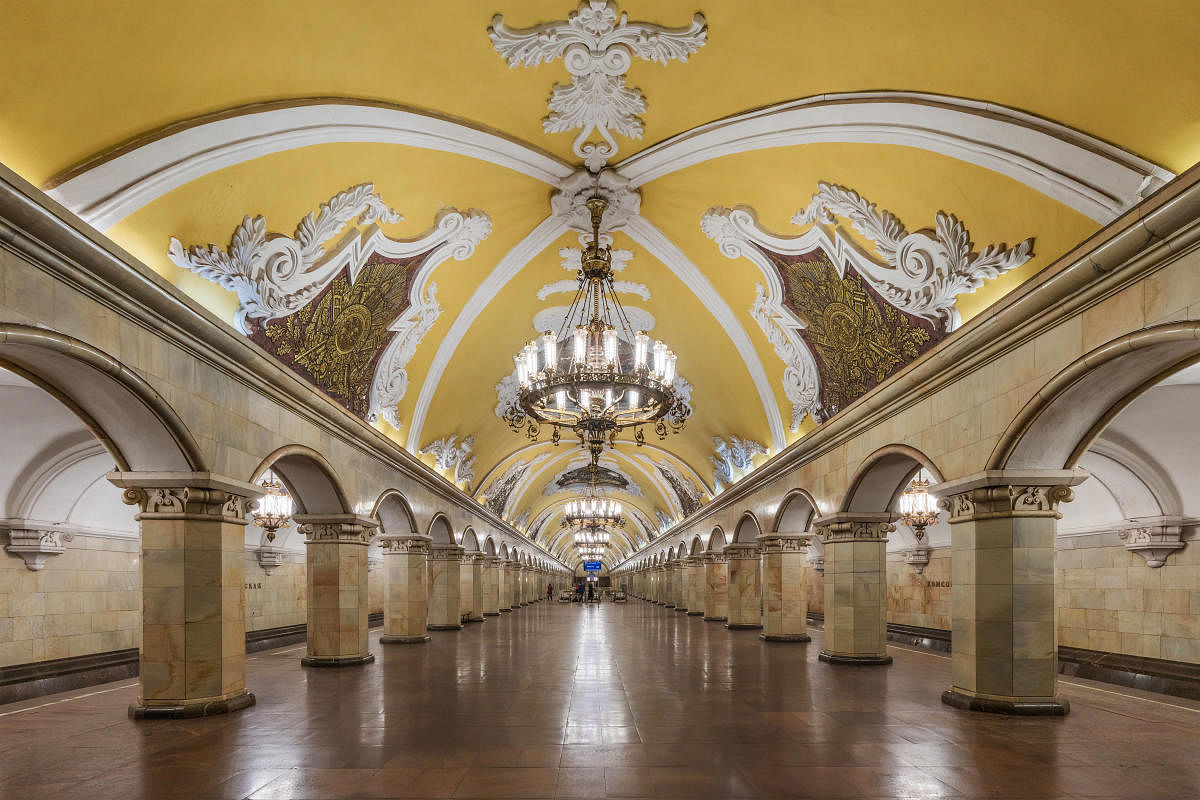
There is incredulity all round. A sightseeing tour to a Metro station? Especially after an enchanted morning at two magnificent cathedrals? The guide, obviously used to such reactions, smilingly leads the way to a big block of grey cement and plain glass, a standard-issue public convenience building. We cross the turnstiles and take an escalator. It glides down, for what seems like forever, and ends in a cavernous corridor. Stunned! Giant Roman columns with ornate capitals, polished inlaid granite floors, marble walls resplendent with enormous mosaics, polished brass chandeliers, all creating an atmosphere, more of a prestigious Music Hall than a train station. We stand gaping and gawking. And this is just one of the nearly 200 such stations servicing the city.
We begin to understand why Moscow’s Metro Stations are a whole extraordinary league by themselves. Trains run in clockwork precision, frequency being one every 90 seconds. Local commuters get in and out but the station is thronged by groups of tourists, clicking away in wide-eyed wonder. The Metro train system was introduced in Moscow as early as 1923 and the first Subway stations were open by 1935. In spite of the setbacks caused by wars, the Revolutionary Fathers had decided on the ideal of Socialist Classicism, that all people had the right to enjoy luxury and beauty. So, some of the earliest stations were excessively ornate and dazzling to promote the idea of the “Brilliance of Victory” over the oppressive past.
Though the architecture and interior decoration were toned down in later stations, they continued to be unique in some way or the other. Being merely functional was never an option, it seems. Except for a very few stations, all are subterranean, at depths ranging from 35 to 55 meters underground. There are some called Deep Stations, as they go lower. Park Pobedy is the deepest at 84 meters and has the longest escalator, the top of which cannot be seen from the bottom! During the Siege of Moscow, Deep Stations were used as air-raid shelters. Stations built during the Cold War were specifically designed to act as safe bunkers in the event of a nuclear attack.
These Metro stations have earned their right to be regarded as tourist spots and many tour packages are on offer to take in the best ones, involving minimum travel time. The affordable hop-on-hop-off tickets allow tourists to flit from one marvel to the other, with guides providing the history behind each one. To mention a few: Kievskaya, all marble and granite, with 18 colourful mosaics and bas-reliefs, celebrates Russia’s relationship with Ukraine.
Komsomolskaya oozes the Stalinist Empire style with elegant chandeliers, marble arcades and giant mosaics. Novoslobodskaya dazzles with 32 stained glass panels showing narratives and geometric patterns. Novokuznetskaya, built during World War II, has a forbidding look with bronze medallions decorated with guns, shields and the likes hung above marble benches with carved armrests. Ploschad Revolutsii, devoted to the Bolshevik Revolution, sports 76 bronze statues of workers, soldiers and peasants crouching in the alcoves.
The sculpture of a soldier with a dog has an urban myth attached to it. Students dutifully rub the dog’s nose for luck in exams!
Okhotny Ryad, opened in 1935, is fully clad in marble and is one of the longest underground stations in the world. It leads to The Red Square.
With functionality coupled so gloriously with art and beauty, the Metro stations of Moscow are truly People’s Palaces, as their original creators had envisioned.